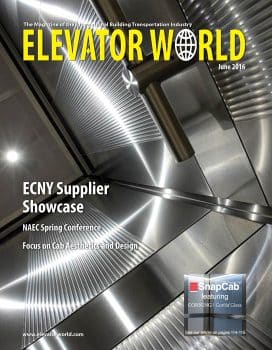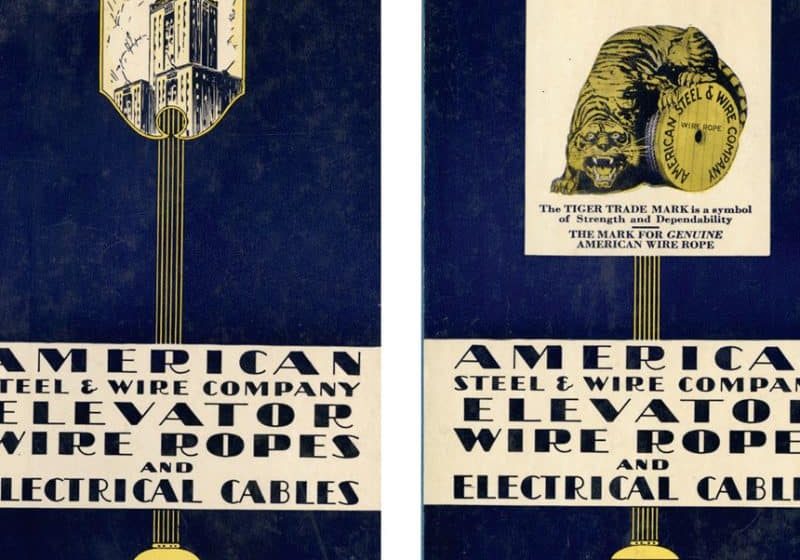A review of a technical yet practical manual for those ready to dig deeper for continuing education.
Educational Focus, Volume 2, approved for continuing-education credit, consists of technical articles published in ELEVATOR WORLD between 2005 and 2013. The authors stretch from the U.S., U.K., China, Germany and Japan to the Netherlands. EW Technical Advisory Group member Dr. Albert So selected the contents for and edited this volume – a follow-up to the successful Educational Focus published in 2003. He grouped the articles into four sections – “Drives,” “Ropes,” “Brakes” and “Components.” Each section opens with an introduction by So and closes with assessment examination questions. New to the second volume are tutorials following each article with learning-reinforcement questions.
Keeping Up with the Technical Times
The Educational Focus series is designed for readers interested in new technical knowledge. Since the first volume was published more than a decade ago, So notes “elevator technology has seen a quantum leap.” The new book, thus, serves as an easy reference for technical readers.
Dr. So has been writing for EW for more than 10 years as an international correspondent. He has also contributed technical articles and used the original Educational Focus as a textbook for his university classes. He selected pertinent topics, then searched the EW archives for representative, high-quality articles published in the last 10 years. They could not be too academic or trivial but useful to industry professionals. Donning his professor’s cap, he added supplementary tutorials to each article, prepared new learning-reinforcement questions and designed the assessment examination questions.
The first section is on elevator drives, the “prime mover of all traction elevators.” Its seven articles, published between April 2005 and December 2011, discuss variable-voltage, variable-frequency drives, permanent-magnet gearless motors, drive-control systems, traction drives, machine-room-less elevators and power quality. The second section covers ropes and suspension means. After drives, they are the most important component of traction elevators, because ropes can deteriorate quickly and create a safety hazard without proper maintenance. This section’s seven articles, published between March 2006 and March 2013, cover wet ropes and the lubrication and maintenance of steel-wire rope. The third section delves into brakes, which are crucial for safety. Its three articles, published between June 2010 and January 2011, address new developments in brake actuation from the past decade. The final section covers elevator components. Its three articles, published between September 2008 and February 2011, explore hoistway equipment, car refurbishment, mechanical and structural systems of elevators, cab structure, balance and guide rails.
Technical Yet Practical
Word count was used to determine the number of continuing-education contact hours each section is worth. Section I on Drives is worth 6 hours, Section II on Ropes 6 hours, Section III on Brakes 2 hours and Section IV on Components 5 hours. The entire book is valued at 19 hours, and exams can be taken over a three-year period as needed. All exams must be taken online.
According to So, the most challenging part of the project was composing the test questions. All the answers should be found in the article without needing to reference another resource, so, readers are encouraged to pay close attention to the details, as well as the general thrust of an article. This is a book to work through slowly and thoroughly, but don’t lose heart if you do not grasp everything. You are in good company. So says:
“It is not easy for a reader, even an expert sometimes, to thoroughly understand every sentence in a particular technical article. That’s why ‘Tutorials’ are needed for further explanation and assistance.”
While the manual is technical in nature, it is also of practical use to technicians and inspectors in the field. For those who find themselves a little intimated by the technical content, there is good news. The derivation of equations is included in the tutorials, which, So notes, “is mainly for the interest of those readers who love mathematics.” It is often not necessary to completely understand the derivation to understand an article and try to answer questions on it.
Educational Focus, Volume 2 is available at www.elevatorbooks.com, email: [email protected], or phone: (251) 479-4514, ext. 19.
Interview with Editor, Dr. Albert So (AS)
EW: What are some of the important changes you have seen in the vertical-transportation industry?
AS: I can see two obvious changes over the past decade. First, as buildings are getting taller and taller, elevator design is becoming more challenging. But, that is good news to the industry, as this branch is becoming more important compared to other building systems.
Second, decades ago, the vertical-transportation industry was mainly mechanically oriented. Now, it is shifting toward electronics, microprocessors, computer applications and the involvement of artificial intelligence. Even some very classical safety devices see a trend in becoming more electronics reliant, which was not possible in the past.
EW: How do you think the industry will change in the future?
AS: Elevators will become a new means of overall transportation within buildings or even around building clusters – not just merely a vertical-transportation system anymore. What I mean is that elevator systems will evolve from one-dimensional to two-dimensional and, finally, to 3D. A lift car can bring passengers to any destination in a building by moving both vertically and horizontally. Multiple and independent cars moving along hoistways will become the trend, while ropeless linear machines will be everywhere, just like a vertical and horizontal railway system.
EW: What have been some of the highlights of your career so far?
AS: I feel privileged to be able to get in touch with this industry from an academic and R&D point of view. As a university professor, I need to teach the fundamental and latest technologies of elevator systems. Through consultancy and being an expert witness in court cases, I have had a chance to confront practicing engineers in the industry. Through code writing in Hong Kong for the government, I have been able to keep abreast with the international trends and what is readily available on the market. Through being the scientific advisor of the International Association of Elevator Engineers, I have benefited from making lots of professional friends and colleagues around the world. Finally, through contributing to EW, I have had the opportunity to share my research findings and perspective with its readers.
EW: What challenges have you faced? How did you overcome them?
AS: Until now, among all building systems – including heating, ventilating and air conditioning (HVAC); lighting; electricity distribution; security; building automation; and life safety – I could say the elevator industry is still one of the most confidential industries around the world, full of commercial secrets. Besides a few industry magazines and a limited number of books available on the market, it is extremely difficult for laymen to come across information on elevator technologies, not to mention doing research on various components, unless you are working with an international manufacturer. Articles related to elevators are rare in academic journals. Even installers and maintenance contractors very often face difficulties in getting adequate information. I have been a little lucky in having so many friends who could supply me with information and advice and in being associated with university research centers, which are limited, around the world. I hope more scholars in universities will become interested in elevator systems and delve into this subject. Then, we can have more references to the technical aspect of this industry.
EW: What advice do you have for young people in the industry today?
AS: Many laymen may believe elevator engineering is only a trade practice, neither academic nor high tech in nature. But, I can tell young people that technologies engaged in an elevator system are far more advanced than in any other building systems. For example, variable-voltage, variable-frequency drives were popularly used in the mid 1980s in elevator systems, while they were still quite new to the HVAC industry. New motor types, such as permanent-magnetic synchronous machines and reluctance motors, are becoming widely accepted. Supervisory control of elevators was the pioneer to engage algorithms of artificial intelligence in the mid 1990s. Linear motors have been popularly used for door operators for more than a decade, while the application in other building systems is still very limited. Elevator engineering is a combination of electrical, electronic, computer, mechanical, structural and material engineering. If someone is well acquainted with different technologies of an elevator system, they could easily understand any other systems installed in modern intelligent buildings.
Get more of Elevator World. Sign up for our free e-newsletter.






